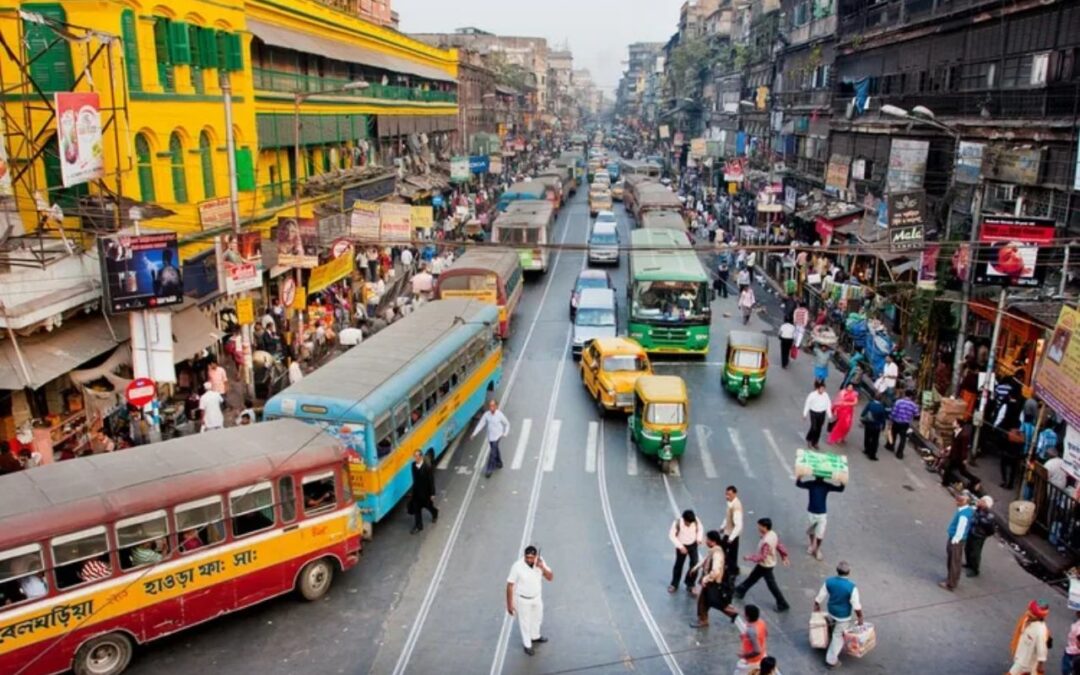Synopsis- Population in India is majorly led by 7 metropolitan cities in India, Whose population collectively accounts for quarter of the nation’s population with each city having a population of over 9 million. Explosive economic growth, rural-urban migration and the massive injection of infrastructure investment have fuelled these city expansions. But, the increased population has led to rising- congestion, pollution, lack of housing and overloaded transport networks. This article provides a city wise estimate of the population, major factors influencing the population growth and major problems faced in the cities
1. Delhi
- Estimated Population of Metro (2025): 34,666,000
- Growth Trend: An annual growth of 2.54% since 2024.
- Between 2022 to 2025, Delhi metro area gained more than 2.6 million inhabitants, driven by:
- Career Opportunities: Government services, IT, finance and hospitality industries.
- Migration: In-migration of Uttar Pradesh, Bihar and neighbouring states seeking higher wages and higher education.
- Infrastructure: Further extension of metro railway Delhi (Phase III to be completed) and new expressways.
- Challenges:
- Severe air pollution.
- Jam on arteries; average speed of commuters below 20 km/h.
- Lack of affordable housing in the outer suburbs.
2. Mumbai
- Estimated Population of Metro (2025): 22,089,000.
- Trend in Growth: 1.92% rise in 2024.
- The development of Mumbai is quite good and is supported by:
- Economic magnet: Banking, Bollywood and Financial Capital hosting stock exchanges.
- Migration: Constant migration from rural Maharashtra, Uttar Pradesh and Odisha.
- Education: High-level institutions (IIT Bombay, Mumbai University) which have students from all parts of the country.
- Challenges:
- More than 40% of residents live in the slums.
- Extreme traffic congestion on Western and Harbour lines of suburban rail.
- Climate change that increases the coastal flooding risk
3. Kolkata
- Estimated Metro Population 2025: 15,845,200
- Trend Growth: 1.76% annual increase.
- Main reasons for increase in population is:
- Port authority and trade: One of the busiest ports in India easing commerce.
- Education and healthcare: Famous universities and health clinics.
- Urban renewal: Renewal of waterfront precincts.
- Challenges:
- Constant traffic jams; average road speed of 17 km/h.
- Air and water pollution in Hooghly river
- Lack of formal affordable housing.
4. Bengaluru
- Estimated Metro Population: 14,395,400
- Trend in growth: +2.76 percent previous year
- The high surge in Bengaluru is a result of:
- IT and startups: Silicon Valley of India: the tech hub attracts software engineers and entrepreneurs.
- Higher Education: A number of top notch educational institutions.(IISc, IIM Bangalore)
- Weather and diverse culture: Pleasant weather is what Bengaluru is famous for. People from every part of India are in Bengaluru making it home away from home.
- Challenges:
- Shortage of water in the summer months.
- Traffic congestion, Bengaluru is ranked worst in terms of commute time in India.
- Rapid urbanization and improper planning causes water logging problems and inadequate public services.
Also read: Top 9 Bengaluru Suburbs for First-Time Homebuyers in 2025 – Where Should You Invest?
5. Chennai
- Metro Population estimate 2025: 12,336,000
- Trend of growth: +2.34% per annum
- The drive of population growth:
- Automobile manufacturers: has major OEM plants and is referred to as the Detroit of India.
- IT corridor (OMR): Red hot growth of tech parks and co-working places.
- Port and logistics: Ennore and Chennai ports enhancing trade.
- Challenges:
- Floods sweep out frequently during monsoon.
- Salt-water intrusion and ground water depletion.
- Traffic jams in major highways, particularly in OMR.
6. Hyderabad
- Projected Metro Population (2025): 11, 338, 000
- Trend of growth: +2.43% from 2024
- The demographic explosion of Hyderabad is a revealer:
- Pharma and IT: Great centers of pharmaceutical R&D and software services.
- Migration: large in-migration of Telangana and Andhra Pradesh residents.
- Infrastructure: Outer Ring Road and metro Rail connectivity.
- Challenges:
- Increasing population density (18,161 people/km 2), more than that of Delhi.
- Urban strain being because of rapid peripheral growth.
- Industrial effluents that cause pollution to the Musi River
7. Ahmedabad
- Estimated Metro Population 2025: 9,062,000
- Trend of growth: 2.35 percent from 2024
- Growth driven by:
- Manufacturing: Textile and petrochemical Industries Situation.
- Education: Many Educational Institutions including IIM and NID campuses.
- Urban schemes: Sabarmati Riverfront project.
- Challenges:
- The fluidity of water depends on monsoons and monsoon-fed reservoirs.
- The pertinent issue of air pollution caused by industrial clusters.
- Shortage of affordable housing in expanding suburbs.
Comparative Population Table
| Rank | City | 2025 Pop. | Annual Growth | Key Driver | Major Challenge |
| 1 | Delhi | 34,666,000 | +2.54% | Government & services, migration | Air pollution & housing shortage |
| 2 | Mumbai | 22,089,000 | +1.92% | Finance, entertainment, migration | Slums & transport congestion |
| 3 | Kolkata | 15,845,200 | +1.76% | Port trade, education, urban renewal | Traffic & pollution |
| 4 | Bengaluru | 14,395,400 | +2.76% | IT industry, higher education | Traffic & Water Scarcity |
| 5 | Chennai | 12,336,000 | +2.34% | Automotive, IT corridor, logistics | Flooding & groundwater depletion |
| 6 | Hyderabad | 11,338,000 | +2.43% | Pharma & IT, infrastructure | Infrastructure strain |
| 7 | Ahmedabad | 9,062,000 | +2.35% | Manufacturing, education | Water & air pollution |
Main Factors of Rapid Urbanization
1. Economic Pull
- Agglomeration economies: Any 10% increment in the population of a city can increase the productivity by 2-4 % due to knowledge spill-over (urban elasticity model of World Bank).
- Sectoral concentration: Finance in Mumbai, IT in Bengaluru and Hyderabad, auto in Chennai, government in Delhi, port trade in Kolkata and textiles & petrochem in Ahmedabad- specialisation attracts both capital and labour.
2. Migration
- The data on high frequency mobility in the country reveal 40 crore individuals moving each year, with Delhi, Mumbai and Bengaluru being among the top arrival nodes.
3. Infrastructure & Policy
- The metro rail network in the top 7 cities increased from 620 km in 2014 to 1,526km in 2025 reducing the dependency on roads.
- The policies revolving around FDI actively direct capital flow into well defined corridors, which tend to attract job-seekers.
4. Institutional Factor & Social Factor
- Density of higher education: These metro cities have top 100 universities in India.
- Lifestyle: The cosmopolitan culture, night life, standards of healthcare and worldwide connectivity increase gravitation towards urban lifestyle.
Urban Challenges Snapshot
| Dimension | Delhi | Mumbai | Kolkata | Bengaluru | Chennai | Hyderabad | Ahmedabad |
| PM2.5 (µg/m³) | 104.7 | 36.1 | 44.8 | 29.3 | 18.7 | 21.4 | 24.6 |
| Avg. Commute (10 km) | 26 min | 29 min | 35 min | 34 min | 30 min | 32 min | 29 min |
| Annual Flood Cost | ₹2,500 cr | ₹1,800 cr | ₹1,200 cr | ₹1,100 cr | ₹11,000 cr* | ₹850 cr | ₹600 cr |
| Water-table Fall (2023–24) | 1.5 m | Coastal salinity risk | <1 m | 2–7 m | Minimal (rain-fed) | 2–7 m | <1 m |
| Slum / Informal Pop. | 24% | 41.3% | 31% | 9% | 28.9% | 24% | 17% |
Final Thoughts
The seven largest metro cities in India are considered the centers of economic growth and innovation, yet they grow so fast that it is associated with a certain cost. Whether it be air pollution and traffic congestion combined with water shortage and housing stress, these metropolises experience a complicated combination of issues and will not be sustainable in the long-term. This growth would require proper governance of cities, development of climate-resilient infrastructures, and inclusive housing policy. As India continues to get urbanized, the future of this country will depend on how these cities adjust and prosper.
Written by Prajwal Hegde




